|
For Story Structure |
|
For Story Development |
|
|

Read the Science Fiction Thriller
From the founder of Storymind
Man Made follows a mysterious force as it sweeps around the globe erasing anything man made -
Governments stagger under the panic, religions are at a loss for an explanation, scientists strive for any means to stop or divert the phenomenon, and the world’s population from families to individuals struggle to prepare for The Event, which will drive humanity back beyond the stone age.
The Event is coming.
Are you prepared?
Copyright Melanie Anne Phillips
|
|
Free Writing Resources

creator StoryWeaver, co-
|
Novice Writers |
Creative Writing |

Copyright 1999 C. J. Lofting

The fundamental concept regarding the I Ching is that there are potentially billions of them, not just one. The one is more of a template and as such consists of line symbols and a generic name that captures the general 'feel' associated to the symbol. The line and judgement texts can be ignored to a degree where, if you make-
This template emphasis exists as part of the text of the I Ching (or Yijing) where:
"The character jing is normally translated as 'classic', hence the title Jijing is often given as the Classic of Change. But jing literally means 'a warp thread', ie. the threads that run from top to bottom of a fabric" p11 Fancourt, de W., (1997)"Warp & Weft: In search of the I Ching" Capall Bann
In this sense, every person on the planet could create their own I Ching, and when compared we would find similarities that reflect the species-
The experience is then encoded, symbolised, and this method of information processing, what we call metaphorcation , is where we transfer meaning to a 'carrier' of it, allowing for general and particular sharing of information where the metaphors/symbolisms elicit emotional resonance. The ultimate form of this manifest as words where the words act like stones in that, thrown into the pool of emotion that we all share, creates waves of meaning; also manifest in the expression of 'hitting the right chord'. Another analogy is to a holographic system where the word act as a reference beam that when 'shone' on the holographic film we have of our lives 'in here' acts to bring-
To demonstrate multiple I Chings I have taken sets of categorisations from a couple of areas including an online drama book that makes the distinctions of characters and plots and their use in creating plays. Within these distinctions are used pairs (dichotomies) to emphasise relationships and utilising the dichotomy template I have refined these categorisations to show relationships across all of them; the many reflect the one.
This gives us 6 "I Ching"s to compare and detect the underlying common pattern of meaning -
The ease with which I have been able to do this is due to the manner in which the original categorisations were unconsciously made using the proposed template and the discussion on the template I leave until last since it is an abstract concept that, without having any 'filling' can seem 'meaningless'.
The CHARACTER I CHING.
This I Ching deals with persona types (as well as such Jungean distinctions of ego/shadow/anima/animus etc etc). What we see here is the fusion of (a) The I Ching trigrams (b) fundamental types of the MBTI(R), and (c) the generic character categorisations used by Melanie Anne Phillips & Chris Huntley in their on-
Phillips and Huntley start by making the distinctions of 'drivers' and 'passengers' where the former are the main personas in the drama and the passengers...well, they are there for the ride. This pairing reflects other dichotomies such as leader/follower and so a more cooperative emphasis than rigidly oppositional.
Phillips and Huntley lay out these distinctions thus (see chapter 6 of their online book for Phillips and Huntley's details on behaviour):
Drivers:
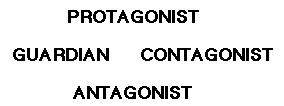
This compass format has protagonist at north, guardian at west, contagonist at east, and antagonist at south. The common link is the "driver" emphasis which is captured in the I Ching/template as an unbroken bottom line emphasising a 'yang' bias. This emphasis forces the antagonist to not be so 'extreme' as 'pure negation' (all yin) but more of an anoyance. As we shall see, this also forces 'pure yin' to become cooperative in the form of the devoted sidekick.
The Passengers diagram is laid out thus (in one chapter the reason/emotion dichotomy is reversed but in all others the following is used and the template enables us to 'refine' these distinctions and possibly 'correct' a perceptual error):
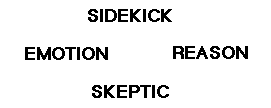
Here we have the same compass format but with the sidekick at north, emotion as west, reason as east, and skeptic as south. The common link is the "passenger" emphasis captured in the I Ching/template as a broken line emphasising a 'yin' bias.
Analysis of these patterns, using the template as a guide, has led to the creation of a corresponding pair of diagrams linking I Ching trigrams with the compass positions:
Compass 1:
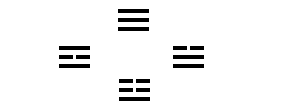
In this compass, reflecting the 'driver' compass, the trigrams are ordered as heaven is north, fire is west, lake is east, and thunder is south.
Compass 2:
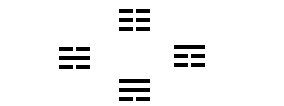
In this compass, reflecting the 'passenger' compass, the trigrams are ordered as earth is north, water is west, mountain is east, and wind is south.
The third set of compasses comes from combining Myers-
Compass 1:
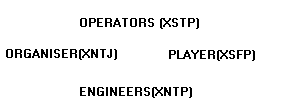
In this compass, reflecting the 'driver' compass, operators (xstp) are north, organisers (xntj) are west, players (xsfp) are east, and engineers (xntp) are south. These definitions can be added-
Compass 2:
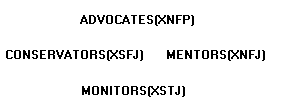
In this compass, reflecting the 'passenger' compass, advocates/disciples (xnfp) are north, conservators (xsfj) are west, mentors (xnfj) are east, and monitors (xatj) are south. These definitions can be added-
The fourth set of compasses comes from the template. Firstly we need to make the distinctions of objects and relationships. We then distinguish two types of objects, those we label as wholes and those we label as parts, recognising that context can affect this labeling process where a whole is a part when viewed from a different level of analysis. Next we distinguish two types of relationships, static and dynamic. We then add the dichotomy of text (foreground, drivers) and context (background, passengers). We note that drivers are expansive whereas passengers are more contractive, they pull inwards or contain rather than push outwards. To add to these distinctions, my analysis of how we describe things suggests that we take the elements of each dichotomy and weave them together, or mix them and we can use mixing terms to describe the general 'feel' for each 'mix':
- Wholes -
- feeling of blending, being or becoming 'one'
- Parts -
- a feeling of bounding, distinction of 'this' from 'that'
- Static Relationships (invarient) -
- a feeling of bonding, establish a bond and so an eternal 'tie'
- Dynamic Relationships (varient) -
- a feeling of binding, retain independence but form a relationship over time, e.g. a contract
Using the contract/expand distinction, so we have contractive blending and expansive blending and so on. Here are the compasses:
Compass 1 (Emphasis on 'facts', expansive) AND Compass 2 ( Emphasis on 'values', contractive):
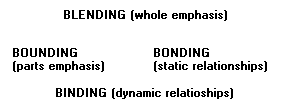
The concept of blending is north for both compasses, bounding is west for both, bonding is east for both, and binding is south for both. We see here the 'generic' nature of this where the same patterns operate for both compasses but, using the I Ching reference, the bottom line makes a difference. The other compasses have words that make the distinctions, my emphasis is to show the 'root' of it all, the 'one' from the 'many'.
When we analyse the other compasses in their own contexts it is possible to pick up these generic distinctions in each and in doing so we realise that ALL of the compasses are 'talking' about the same GENERAL patterns in a very PARTICULAR way. Realising this, we can in fact 'entangle' the compasses to help refine categorisations within each compass by making analogies to the others and I suggest that this is how we can make analogies, the blend, bond, bound, bind distinctions are patterns of emotion that resonate when 'touched' by a word and so generates a sense of 'meaning'. Furthermore, the above formats can be moved about to show other patterns that can generate meanings.
Uniting these compasses, those of the characters with those of the traditional I Ching and the MBTI associations enable us to make the following associations in the context of the Characters I Ching:
Drivers Bias
Generic sensation seekers, they just like driving. Yang bias. Problem solvers (guardian/antagonist) develop out of this -
Protagonist -
Contagonist -
Guardian -
Antagonist -
Each of these types have eight hexagrams that capture their general 'range' of being, and each hexagram has sixty-
Passengers Bias
Generic identity seekers. They are on a journey to seek identity. Yin bias. They lack the precision skills of the drivers but have qualitative skills -
Sidekick -
Reason -
Qualitative 'reason' has a goal of trickary e.g. false retreats to draw the enemy in or to enable one to fight another day. (hex 33). Reason makes you run 'logically'.
Emotion -
Skeptic -
When we drop a few levels so all of these eight types interact and have qualities of the others as part of their psyche, they just have a preferred persona.
For example, the skeptical aspect of the protagonist is manifest by hexagram 9 (skeptic trigram over protagonist trigram) which deals with making small gains and singlemindedly building on those to gain influence. There is thus a lack of trust/faith in 'going for broke'.
The PLOT I CHING.
This maps directly onto the same trigram sets as for characters and so creating a 'plot I Ching' Phillips and Huntley diagram plots as:
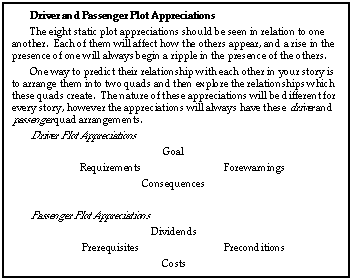
Driver plots (tonic emphasis, single context, totalist):
Goal -
Requirements -
Forewarnings -
Consequence -
Passengers plots (harmonics emphasis, multicontext, relativist):
Dividends -
Preconditions -
Prerequisites -
Costs -
COMBINATIONS AND FEEDBACK
When we combine these "I Chings" so we can see that:
- The goal of the skeptic is hexagram 44 -
- persuasion, seduction. - The goal of the emotion is hexagram 06 -
- compromise - The goal of the reason is hexagram 33 -
- retreat/trickary (ensure we fight another day) - The goal of the sidekick is hexagram 12 -
- neutralise opponants and so confirm faith - The goal of the antagonist is hexagram 25 -
- disentanglement, stand- out, say one's piece (innocense), break- free - The goal of the guardian is hexagram 13 -
- form loose associations with the likeminded - The goal of the contagonist is hexagram 10 -
- treading the correct path - The goal of the protagonist is hexagram 01 -
- singlemindedness; precision
Phillips/Huntley state that "Requirements are the essential steps or circumstances which must be met in order to reach the story's/character's goal" and when we include the other I Chings so we can see developmental patterns where the given hexagram meanings etc do suggest these requirements are needed for the above goals:
- The requirements of the skeptic is hexagram 50 -
- 'proper' cooking; transformation. - The requirements of the emotion is hexagram 64 -
- missequence, make an error - The requirements of the reason is hexagram 56 -
- restrained journeying (loyalty to the cause even if far away) - The requirements of the sidekick is hexagram 35 -
- progress, firming ideology - The requirements of the antagonist is hexagram 21 -
- biting through, chew- over a problem and generate an algorithm, rule. - The requirements of the guardian is hexagram 30 -
- guidance/establish a sense of direction - The requirements of the contagonist is hexagram 38 -
- obstructions/mirroring - copy/reflect others - The requirements of the protagonist is hexagram 14 -
- central management, directing affairs
Phillips/Huntley state that "Consequences are dependent upon the goal [previous section]...consequences may be expressed as what will happen if the goal is not achieved.." Again, adding-
- The consequence of the skeptic is hexagram 32 -
- commitment - The consequence of the emotion is hexagram 40 -
- loosen the structure (tension release) - The consequence of the reason is hexagram 62 -
- protraying/acting (over exagerate) - The consequence of the sidekick is hexagram 16 -
- foresight/enthusiasm/celebration - The consequence of the antagonist is hexagram 51 -
- enlightenment/awareness - The consequence of the guardian is hexagram 55 -
- overflowing/abundance (eg. of criminals etc) - The consequence of the contagonist is hexagram 54 -
- immature (wasting energy) - The consequence of the protagonist is hexagram 34 -
- motivating
Phillips/Huntley state that "Forwarnings appear as a signal that the consequences[previous section] are imminent"
- The forewarnings of the skeptic is hexagram 28 -
- excess, go beyond what is required - The forewarnings of the emotion is hexagram 47 -
- exhaustion, enforced waiting/entanglement - The forewarnings of the reason is hexagram 31 -
- restrained stimulation - The forewarnings of the sidekick is hexagram 45 -
- congregating/assembling - The forewarnings of the antagonist is hexagram 17 -
- following/believing - The forewarnings of the guardian is hexagram 49 -
- unmasking, revealing the 'truth', molting - The forewarnings of the contagonist is hexagram 58 -
- intensity - The forewarnings of the protagonist is hexagram 43 -
- seeding, spread the word
Phillips/Huntley state that "Dividends are benefits accrued on the way to the goal."
- The dividends of the skeptic is hexagram 46 -
- entanglement. pushing upwards - The dividends of the emotion is hexagram 07 -
- uniformity but therefore hierarchy, 'order' - The dividends of the reason is hexagram 15-
- modesty, levelling- out, to even out, equal - The dividends of the sidekick is hexagram 02 -
- devotion/absolute trust - The dividends of the antagonist is hexagram 24 -
- returning to the path, come back to the fold, and yet explore other ways - The dividends of the guardian is hexagram 36 -
- uncompromising, 'know it all', the perfect 'map'. - The dividends of the contagonist is hexagram 19 -
- approach/defer, can tread on the tiger's tail without fear - The dividends of the protagonist is hexagram 11 -
- harmony/balance/peace
Phillips/Huntley state that "Costs function much like negative dividends. They are the detrimental effects of the effort to reach the goal."
- The costs of the skeptic is hexagram 57 -
- cultivation/influence (where the goal is to pull away, seduce) - The costs of the emotion is hexagram 59 -
- dispell illusions (where illusion is a fundamental element of emotion in the form of bluff) - The costs of the reason is hexagram 53 -
- maturing, refinement (at odds to levelling things out) - The costs of the sidekick is hexagram 20 -
- admiration, setting an example (for the sidekick this should be aimed towards the protagonist, not them) - The costs of the antagonist is hexagram 42 -
- augmentation - The costs of the guardian is hexagram 37 -
- rigid structuring - The costs of the contagonist is hexagram 61 -
- yielding/sympathising - The costs of the protagonist is hexagram 09 -
- making small gains
Phillips/Huntley state that "Prerequisites determine what is needed to begin meeting the requirements"
- The prerequisite of the skeptic is hexagram 48 -
- foundations, a source (the well) - The prerequisite of the emotion is hexagram 29 -
- containment/control - The prerequisite of the reason is hexagram 39 -
- obsticles, get around them - The prerequisite of the sidekick is hexagram 08 -
- attracting, uniting - The prerequisite of the antagonist is hexagram 03 -
- difficult beginnings - The prerequisite of the guardian is hexagram 63 -
- 'correct' sequencing, establish a 'proper' order of events - The prerequiste of the contagonist is hexagram 60 -
- standardisation - The prerequisite of the protagonist is hexagram 05 -
- waiting/serving (bide one's time, serve one's dues)
Phillips/Huntley state that "Preconditions are non-
- The preconditions of the skeptic is hexagram 18 -
- correcting, removing corruption - The preconditions of the emotion is hexagram 04 -
- masking (youthful folly, rote education for social control) - The preconditions of the reason is hexagram 52 -
- discernment - The preconditions of the sidekick is hexagram 23 -
- pruning, cut- back, remove chaff from wheat to reveal the 'pure' - The preconditions of the antagonist is hexagram 27 -
- hungering - The preconditions of the guardian is hexagram 22 -
- facading (beauty, make- up) - The preconditions of the contagonist is hexagram 41 -
- concentrate (lit & met) - The preconditions of the protagonist is hexagram 26 -
- hold firm
We can see from this that not only is this useful for plays etc but for all psychological, and sociological, pathwork, in fact for ANY dichotomy-
We also notice that the same patterns apply at all levels such that, for plots so the goals set 'in the north' but within each element we also find goals as shown in the list above where, for example, the skeptic has a goal (hex 44) other than that for the story as a whole.
FLEXIBILITY
Reflection on the above patterns show that the compasses apply to the ordering of the hexagrams in a binary format around the circumference of a circle. The compasses then fit into the middle of the circle and can be rotated to give variations on the themes.
This is done based on the ability to refine the 'base' trigram compasses into hexagram compasses by mearly doubling each trigram. From this we can easily see the compass format which serves as a 'template' and the hexagrams on the circumference offer variations on the theme. For example, the 'standard' template in linear form is:
protagonist -
When we view the 'passenger' template this way so we have:
Sidekick-
The order is protagonist:contagonist:guardian:antagonist:skeptic:emotion:reason:sidekick
There is a 'flaw' in this in the form of terminologies and that is the associations of reason and guardian. I think these terms should be swapped since the reason brings out the 'direction' setting of the fire trigram and the guardian brings out the gatekeeper manifest in the mountain trigram in that the gatekeeper is discerning and decides who passes and who does not. This discernment element is 'reasonable', emphasising qualitative reasoning.
We can in fact create ONE I Ching compass that reflects all of this:
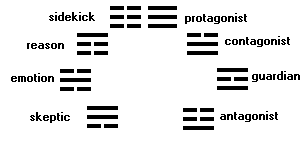
This reflects the structural sequence of Fu Hsi, aka the binary senquence, but rather than show it as a linear oppositional format, introduces a circular cooperative format where the ends of the linear form are brought together to form the circle. This gives us two methods of analysis, one that is struturally symmetric and so 'pure' but also sterile, or else one that is slightly skewed due to the coopertive emphasis, where the skew is the joining of the ends to make a circle and in doing so make the strutural opposite of yang a complementary partner. This I call a sexual categorisation system as compared to the structurally symmetric asexual categorisation system where pure yin and pure yang are in opposition:

If we swing the far right end, down and around next to the left end, we form the compass format of the trigrams.
When the trigram compass is converted to a hexagram compass, where each trigram initially maps to its hexagram (giving us the traditional numbering clockwise, 1-
We can also convert the plot compass set to this one compass.
What this means is that EVERY hexagram manifests properties of EVERY compass point but to bring that out requires relational patterns to set a context that can support such expression both positive and negative.
Holographic mapping: Reference and Interference
Reflecting on what has been said so far, we are dealing with archetypal forces , 'pure' forms (tai chi) with which, once determined, can be aspectually analysed (yin/yang) and the resulting form can become 'tai chi' in their own right and so themselves can be aspectully analysed. This is 'holographic' in that the 'one', the Tai Chi, acts as a reference beam, and the many, yin/yang, the interference patterns.
This allows us to use the SAME patterns at all levels of analysis and this is demonstratable using the goal set to determine a story line. The goal set acts as the reference beam and when combined with the interference beam give us the set of elements within the goal set. In the archetypal format of the compass so we see a hexagram sequence that captures the archetypal plot (note that I have skewed this. The circle form puts the dividend to the left of the goal but I wish to assert the goal first and so follow with the dividend to emphasise the relationship):
- Goal -
hexagram 01 (also the role of the protagonist) - Dividend -
hexagram 02 (also the role of the sidekick) - Forwarnings -
hexagram 58 (also the role of contagonist) - Requirements -
hexagram 30 (also the role of guardian) - Consequence -
hexagram 51 (also the role of antagonist) - Costs -
hexagram 57 (also the role of skeptic) - Prerequisites -
hexagram 29 (also the role of emotion) - Preconditions -
hexagram 52 (also the role of qualitative reason)
This archetype plot(role) serves as the seed for all others. I have listed these below in the above order (if we swap the first two so the list can be overlaid onto the compass with the second position as 'north'. The other choice is to put the sidekick last manifesting opposition, the asexual format. The sexual format forms the circle and so brings the once opposite around to being the sidekick emphasising cooperation where the 5-
01 02 58 30 51 57 29 52 (the archetype plot)
43 01 38 55 42 48 04 15 (variations on the theme)
14 43 54 37 03 18 07 12
34 14 61 63 27 46 33 45
09 34 60 22 24 06 31 35
05 09 41 36 44 47 56 16
26 05 19 25 28 64 62 20
11 26 13 17 50 40 53 08
10 11 49 21 32 59 39 23
58 10 30 51 57 29 52 02 interesting sequence, a shift of the archetype with a replacement of 01 with 10.
38 58 55 42 48 04 15 01
54 38 37 03 18 07 12 43
61 54 63 27 46 33 45 14
60 61 22 24 06 31 35 34
41 60 36 44 47 56 16 09
19 41 25 28 64 62 20 05
13 19 17 50 40 53 08 26
49 13 21 32 59 39 23 11
30 49 51 57 29 52 02 10 further degradation of the archetype, a further shift and a replacement of 58 with 49
55 30 42 48 04 15 01 58
37 55 03 18 07 12 43 38
63 37 27 46 33 45 14 54
22 63 24 06 31 35 34 61
36 22 44 47 56 16 09 60
25 36 28 64 62 20 05 41
17 25 50 40 53 08 26 19
21 17 32 59 39 23 11 13
51 21 57 29 52 02 10 49
42 51 48 04 15 01 58 30
03 42 18 07 12 43 54 55
27 03 46 33 45 14 61 37
24 27 06 31 35 34 60 63
44 24 47 56 16 09 41 22
28 44 64 62 20 05 19 36
50 28 40 53 08 26 13 25
32 50 59 39 23 11 49 17
57 32 29 52 02 10 30 21
48 57 04 15 01 58 55 51
18 48 07 12 43 38 37 42
46 18 33 45 14 54 63 03
06 46 31 35 34 61 22 27
47 06 56 16 09 60 36 24
64 47 62 20 05 41 25 44
40 64 53 08 26 19 17 28
59 40 39 23 11 13 21 50
29 59 52 02 10 49 51 32
04 29 15 01 58 30 42 57
07 04 12 43 38 55 03 48
33 07 45 14 54 37 27 18
31 33 35 34 61 63 24 46
56 31 16 09 60 22 44 06
62 56 20 05 41 36 28 47
53 62 08 26 19 25 50 64
39 53 23 11 13 17 32 40
52 39 02 10 49 21 57 59
15 52 01 58 30 51 48 29
12 15 43 38 55 42 18 04
45 12 14 54 37 03 46 07
35 45 34 61 63 27 06 33
16 35 09 60 22 24 47 31
20 16 05 41 36 44 64 56
08 20 26 19 25 28 40 62
23 08 11 13 17 50 59 53
02 23 10 49 21 32 29 39
One:many feedback, hierarchy, and music.
The initial distinction of whole:relationships is captured in the I Ching as Tai Chi : yin/yang. In the eight positions in the archetype compass, 1-
1-
(1-
((1-
We can refine these relatioships further, thus the oppose/cooperate emphasis is qualified by the blend, bond, bound, bind relational methods inherant in the template 'underneath' the I Ching. We have this created eight more I Chings for each created in that the full I Ching of 64 can be interpreted as manifesting oppositional bounding or cooperative binding etc.
What is noteworthy here is that this base 'template' is related to music, in the form of the archetypal scale of C (pure, no sharps, no flats) Here we see that the semitone positions manifest 'close' relationships and we find that these positions are linked to the protagonist/sidekick relationship (1-
Musically we have:
position -
C
B
A
G
F
E
D
C (octave higher)
This is the archetypal scale; the 'pure' form.We can then apply the SAME process we applied above with the hexagrams to note relationships. In this we have note as text and note as context i.e.:
C in C
B in C
A in C
G in C
F in C
E in C
D in C
C in C (octave)
We next include the same archetype for modes:
V
IV
VI
II
I
VII
VIII
III
